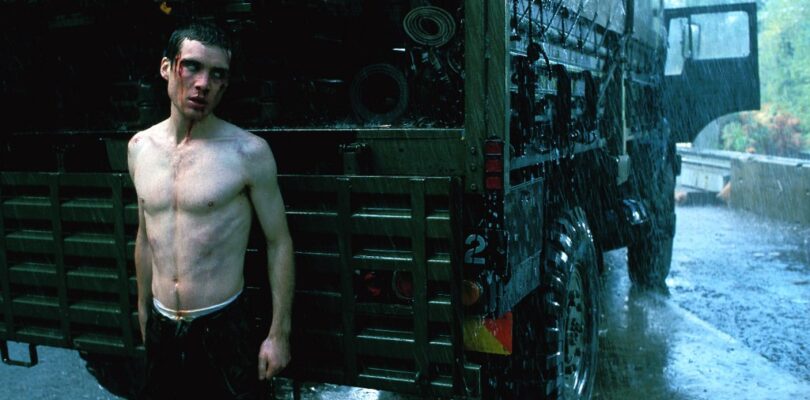“I mean, this is our culture?” Danny Boyle asks, rhetorically. “Right?”
Or maybe he’s not being rhetorical — the British director has a tendency to pose as many questions as he does provide answers during an interview, and seems genuinely interested in having a conversation rather than simply being the “A” half of a Q&A. It’s a Sunday, and Boyle is in New York for a little less than 24 hours. He’s here for a very early screening of 28 Years Later…, the long-awaited third entry in what’s now a trilogy that originated with his 2002 postapocalyptic nightmare of a horror movie. (It’s also technically the first film in a possible new trilogy; more on that later.) Over the next few weeks, there will be press releases showing Boyle posing for events in Paris, Rome, London, and other cities that, were a viral outbreak to occur that causes people to fly into homicidal frenzies, would be turned into metropolitan ruins.
Today, however, Boyle is sitting in a hotel room in the Bowery, and he’s gesturing to everything that’s currently surrounding him. The battalion of lights, set up for a photo shoot set to happen later that day. Some idle video cameras. A smart phone, sitting next to him on a coffee table. The sound of everyday white noise, happening outside of the window facing a busy street. This is what the filmmaker means by “our culture” — a world informed and governed by endlessly innovating, exponentially expanding tech.
“We are now linked so closely with technology and technological evolution that we now evolve with that evolution,” he says. “So if technology stops evolving, does that mean that we as a species stop evolving? What happens when something like an apocalypse interrupts that, or kills it entirely?” Boyle’s default setting is usually buoyant and smiling, but at this particular moment, he looks genuinely terrified. “What happens if our culture dies?”
It’s been roughly 23 years since Boyle gifted us with 28 Days Later…, a variation on the zombie movie that imagined a viral epidemic that turned everyday citizens into raging, flesh-eating monstrosities. Inspired by a trip that screenwriter Alex Garland had taken to a country that had suffered a recent catastrophe, the film ran its bike-messenger hero Jim, played by Cillian Murphy, through a survivalist gauntlet of eerily empty spaces and intense attacks from mindless sprinting hordes. It’s not a leap to suggest that this landmark helped revive a horror subgenre that’s now become ubiquitous, and with the possible exception of the era-defining Trainspotting and the Oscar-winning Slumdog Millionaire, Boyle’s spin on the world falling apart remains his best-known work. “Most films fade, whether they’re successful or not” he admits. “If you’re lucky, one or two sustain a presence. And 28 Days has, for whatever reason, done it. It’s become that movie.”
A sequel, 28 Weeks Later…, dropped in 2007; Boyle and Garland signed on executive producers, but neither were directly involved with the conception of it beyond that. As the years went on and the original’s cult status seemed to keep growing, fans hoped that the two might consider revisiting this patch of fictional scorched earth that only seemed to become more resonant and influential as time passed. The topic would come up repeatedly whenever Boyle and Garland discussed possible collaborations.
At one point, Garland mentioned an idea he had for another potential story that would be set within the 28 Days universe. But he wasn’t interested in writing it himself; now a renowned director in his own right (Ex Machina, Annihilation), Garland was more interested in developing several other projects he’d planned to film. The concept was passed to another writer. A script was turned in. It didn’t work. Then, post-Covid, Garland began writing his own screenplay that imagined what might have happened since we’d last seen the “Rage Virus” ravaging the United Kingdom.
“Yeah, it was completely and utterly fucking generic,” Garland says, laughing, when we talk by Zoom a few weeks after Boyle’s visit. “There’s always been something slightly punk about 28 Days Later…, which I think stems from my age, Danny’s age, and where we grew up. The idea was that a group of military commandos would break quarantine and try to get to the place where the virus had originated, in order to find a cure. When they got there, they found another group that had got there first, and who were trying to weaponize the virus. The punk element was that the commandos would be Chinese Special Forces, and the film would be completely in Mandarin and subtitled, and just sort of be fucking with people in various ways.”
There were shootouts and mass attacks and big, action-adventure–style set pieces, Garland notes, “and I could think of a bunch of filmmakers who could have effectively picked it up and run with it.” But even he felt it was the sort of story where you could easily predict every turn, every beat long before the story got there. That sense that this wasn’t quite the ticket was confirmed when he gave the script to Boyle.
“Danny, in effect, said to me: ‘Alex, are you kidding?’” he admits. “He didn’t come out with it quite that bluntly. Or maybe he did. But he very nicely kept trying to make it work, suggesting ‘what if we did this, what if we did that?’ Finally, we both gave up on it. But oddly enough, writing something so generic was the freeing element to all of our problems. It gave us permission to have a totally blank slate. And it coincided with me not wanting to direct anything for a bit. I was very much into the idea of writing something for somebody else.”
What the two of them conceived for what would be called 28 Years Later… was the notion of a community living in virtual isolation on a place called Holy Island on the Northern coast of England. It would focus on a family, comprised of a father (Aaron Taylor-Johnson) who was among the group’s leaders; his young son (Alfie Williams); and a mother (Jodie Comer), who isn’t infected with the virus but appears to be mysteriously sick. Rather than trying to get their arms around the aftermath throughout the whole world, they’d concentrate on how almost three decades of living under the shadow of death had changed life for these characters. It would be more of a folk-horror movie, with an emphasis on nature — and the absence of technology; see the culture-dying comment above — yet would still be in sync with the intensity of the first film. “By going smaller,” Boyle observes,” it allowed Alex to actually go bigger and deeper. It was brilliant.”
Once they had 28 Years‘ center, they could build out from there. The island would be connected to the mainland via a causeway that gave them access during low tide. In the intervening decades, the virus had mutated, which meant you had some victims who’d learned to feed off grub on the ground (the corpulent, slithering “crawlers”) and others who formed into primitive packs. These would be led by what the duo termed “Alphas”: stronger, faster, smarter, deadlier hunters. Boyle was obsessed with the idea of toxic social regression that revolved around the imaginary “good old days” — think MAGA, Brexit — and introduced elements of Britain’s pre-WWII military campaigns, Henry V fixations and controversial historical totems like the St. George’s flag into the narrative. “The virus needs to move forward,” the director says. “The British human beings left to fight it are moving backwards.”
And they created an indelible boogeyman that would dominate the film’s second half, with the young boy transporting his mother to the mainland in search of a cure: a physician named Kelman, who’s isolated himself in the wilderness and taken on a mythological persona as a gone-rogue madman. He’s one part Dr. Livingston, one part Colonel Kurtz. (“I wasn’t thinking Livingston,” Garland admits. “I was definitely thinking Kurtz. An inverse Kurtz.”) Played by Ralph Fiennes and introduced barely clothed and covered in red-orange iodine, he’s immediately telegraphed as a villain. Kelman, however, turns out to be a far more complicated character than he seems at first glance. [Numerous spoilers ahead, consider yourself warned.] “Ralph was doing an interview while I was still editing the film,” Boyle says, “and someone asked him about playing the ‘villain’ in this. He answered, ‘Oh, don’t worry everyone, I’m one of the good guys!’ And it’s like, Ralph, that’s supposed to be a surprise, you’re not supposed to say that!”
Cillian Murphy in the original ’28 Days Later…”
©20thCentFox/Everett Collection
Speaking of what’s kosher to talk about in regards to 28 Years Later…: There’s had been rumors that Cillian Murphy’s Jim would make an appearance in this new film, thus connecting this final trilogy entry to its ground-zero starting point. That seemed to be confirmed by the appearance of an emaciated infected wandering through a field in the trailer, who bore a striking resemblance to the former bike messanger.
“Yeah, that… oh, man,” Boyle says, putting his head in his hands before letting out a loud guffaw. “Somebody told me, ‘You know, everyone’s going to think that’s Cillian,’ and I just said, ‘Don’t be ridiculous.’ And of course she was right! I mean, the evidence was right there in front of my eyes. The actor who plays that infected person looks just like him. You could easily see that shot in the trailer and go, ‘Jesus, what the fuck happened to Cillian’s character?!’”
So, Boyle says, for the record, that it’s not Jim. Murphy’s hero, however, will briefly show up in the second film, 28 Years Later…: The Bone Temple, which director Nia Da Costa (Candyman) has already shot and will be released next January. A sequence at the end of 28 Years Later… introduces a gang of acrobatic, track-suited wanderers collectively known as the Jimmys, who’ll be a big part of the next movie. Boyle describes it as “essentially a debate about the nature of evil between Kelman and the head Jimmy, played by Jack O’Connell. And Alex and I have written a third film, and that will be Cillian’s movie. It would bring everything full circle. They have not given us the money to make it yet; it will depend on how this one does.” He stops for a second. “I don’t know if I’m supposed talk about this….” [Note: Boyle will spend the next two weeks on a press tour talking about this.]
For now, the director is excited to return to this world, and to have done so in a way that honors the original without being a slavish copycat or a fan-service cash-in. He’s aware that, unlike 2002, he’s bringing this threequel out in a world that’s had not just two-plus decades of a Zombie Entertainment Industrial Complex (“I wish we got a percentage of all that!” Boyle jokes) but a vastly changed sociopolitical landscape.
“Next to Potter and Bond, I think horror is our biggest cinematic export,” Boyle says with a smile, referring to the U.K.’s film industry. “Fear is what horror is all about. And I think not just in England, but all around the world right now, fear is what everyone’s feeling. It’s not just in our culture. This fear of the end — it’s universal. But you can’t let things end. You have to go on.”





